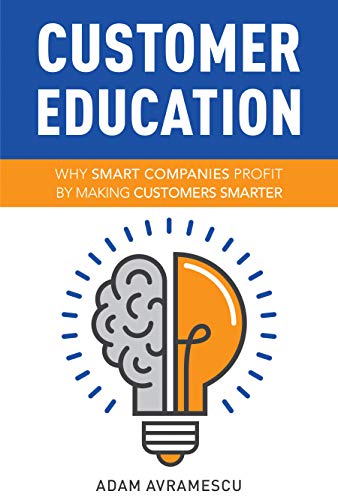What are the key customer education leadership skills you need? Join Adam and Dave as they dive into three great skillsets, each one of which ties to a book. These are required reading material for new and aspiring Customer Education leaders.
- Mindset by Carol Dweck
- Multipliers by Liz Wiseman and Greg McKeown
- Tribal Leadership by Dave Logan, et al.

This post corresponds with Episode 8 of “CELab: The Customer Education Lab.” Subscribe and download our latest episode on our site, Apple Music, Google Play, Stitcher, Spotify, or wherever quality podcasts are found.
Even though I recently published a book, that’s not what this post is about. Today I’d like to share three books that not only every Customer Education leader, but every leader, should read. Each one corresponds to a key mindset that enables us to create a sense of growth and experimentation on our team, and to maximize the potential of every single team member. After all, we succeed or fail together.
Leadership Skill 1: Forget “natural gifts” and embrace the Growth Mindset
Customer Education Leadership Skill #1: As a Customer Education leader, I’m constantly in the position of watching people stretch outside of their comfort zone. Whether it’s a participant in a class, or a member of my team taking on a new project, there will always be that frustrating moment where we throw up our hands, saying, “I just wasn’t built to do this!”
In fact, according to the research of Dr. Carol Dweck, a Stanford psychologist, we’re conditioned from a very early age to regard our skills as fixed and unchangeable. We’re either good at something or we suck at it. But is this reality? According to her research, it’s not — and once we stop believing that our skills our fixed, we can actually change.
In her book Mindset: The New Psychology of Success, Dweck recommends that we think differently about our own abilities. Instead of assuming that we’re good or bad at something, and working hard to protect our own ego around those things, we should instead embrace the idea that we can grow in any area with practice. But for many of us, we don’t do the things that we’re bad at because we don’t think we can get better at them. We’re afraid of failure. If, instead, we treat those failures as opportunities to learn and improve, then we will stop protecting our self-image and start getting better at things!
This is obviously important on a Customer Education team. Even though I recognize that everyone has certain “superpowers” and will more easily excel in certain areas, it’s dangerous to assume that skills won’t change over time. By embracing the growth mindset and learning from failures, we can experiment and push into new areas of growth.
Customer learning professionals can also take the growth mindset into account as they design courses. We can explicitly encourage our customers to be vulnerable, put themselves out there, ask the “dumb” questions, and try and fail in a safe space. We can give them challenging activities that may be outside of their comfort zone because the learning will be that much greater. You might even try sharing Dweck’s research at the beginning of your course.
Leadership Skill 2: Stop glorifying yourself and start multiplying others
Customer Education Leadership Skill #2: At this point, most of us know that it’s not empowering to micromanage employees or to build empires of “B- and C-players.” And yet many of us still do just this. But those aren’t the only ways we prevent our teams from reaching their top potential. We have habits that unconsciously diminish our team’s efforts as well. For example, many leaders believe that they must be the most intelligent person in the room. They must have all the answers. They must make the decisions.
In Multipliers: How the Best Leaders Make Everyone Smarter, Liz Wiseman (who led Oracle University — a learning professional!) and Greg McKeown (author of another one of my favorite books, Essentialism) break down the approaches that multiply the power of a team, in essence making everyone smarter and more empowered. They contrast them with the behaviors that accidentally or intentionally diminish a team. For example:
- Choose to be a Talent Magnet, not an Empire Builder. Prioritize bringing in the best and spending time developing them, not “B-players” who are simply compliant to you.
- Choose to be a Liberator, not a Tyrant. Instead of creating a culture of fear and avoiding mistakes, encourage people to try and fail, and require rapid learning. (Does this sound like the Growth Mindset? I think it does.)
- Choose to be a Challenger, not a Know It All. Instead of having all the answers or solutions, encourage your team to solve problems together. (I personally struggle with this one and have to remind myself to shut up and give people space!)
- Choose to be a Debate maker, not a Decision maker. Create an environment where people can give opinions on hard problems, instead of trying to end the debate too early. Ask good questions to make sure perspectives and nuances are heard before making a decision.
- Choose to be an Investor, not a Micromanager. Instead of telling people what to do, tell them what you expect. Instead of delegating tasks, delegate end goals and outcomes.
Leadership Skill 3: Evolve your tribe from “I’m great” to “We’re great”
Customer Education Leadership Skill #3: The final book in my leadership trilogy is Tribal Leadership: Leveraging Natural Groups to Build a Thriving Organization. This is actually the one I read first, and I think it may have had the most lasting impact on my career. (More time to marinate, I guess.)
The books authors (Logan, King, and Fischer-Wright) posit that within an organization, natural groups (or “tribes”) of 20-150 people compose the culture of the organization, and as a leader, you can help these tribes evolve. Tribes go through different stages, starting with a selfish and downright gloomy mindset (“life sucks,” “MY life sucks”) where they may give token compliance to the things you say, but they’re not really bought in.
It turns out that tribes with this mindset are often being held down by people in the next stage — “I’m great” — where individuals compete against one another.
So how do you escape this destructive pattern? You have to move from “I’m great” to “We’re great.” Align your team around a higher purpose and a common goal, instead of encouraging them to compete against one another (or against other teams in your organization). The book provides examples of how to do this, such as opening up decision-making from a hub-and-spoke model with you at the center to “triads” of individuals — groups of three with more distributed decision-making.
Here’s the part that blows my mind: the authors point out that a big way they know that tribes have made the shift is “a language and a pattern of behavior; not a permanent state like tall or short.”
So in other words, they’re describing a sort of growth mindset! I believe that it’s the same mental shift that lets you move from fixed to growth mindset, from diminisher to multiplier, and from I’m great to We’re great. If you read these books, in order, through this lens, I believe you’ll emerge with a fresh perspective on how to grow a high-performing team — not just in Customer Education, but in any field.
